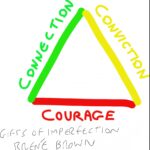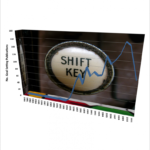The Strange Strength of Vulnerability
Here is a paradox – the strongest systems are those that are most susceptible to change. They are the ones that have a lot of connections. The more connected a person is, the more sources of support they can draw upon when they are struggling. The more people in a person’s network, the more likely that they can recover rapidly from a career reversal and find something else to do.
Yet, each time we make a connection to another person we must overcome the hurdle of vulnerability. We are putting ourselves out there for tacit judgement by the person we are attempting to connect to – will they accept us or not? If fear gets the better of us, rejection can be internalised as confirmation of our own worst fears about our worth. Or worse, we never get to the rejection, because fear makes us get in first and blocks us even reaching out in the first place.
It is tempting (and common) to believe that self-sufficiency is the best way of building strength and resilience. As Paul Simon wrote “I am a rock, I am an island, and a rock feels no pain and an island never cries”. However real islands are very vulnerable. If the resources on the island run out, they are dependent upon outside links for their survival, and if the link to the outside world is cut, the result can be catastrophic.
It turns out that the most resilient systems are the most interconnected. The island connected to land by many bridges, an air service, a tunnel and many ferry services is far more likely to be able to withstand any degradation or removal of one or several of these links. It is what is called graceful degradation and not catastrophe!
The idea of there being strength in vulnerability is not new, you do not need to go back much further than the Corinthians to appreciate the fundamental and deep seated logic of this idea. However, just because it is true doesn’t mean we should stop trying to understand the idea and communicate it.
In my previous post I celebrated the work of Brené Brown and her book the Gifts of Imperfection, and it was my reading of this that has caused me to think more deeply about the connection between her ideas and the Chaos Theory of Careers.
One way of approaching the Chaos Theory of Careers is to think about ourselves as systems and that these systems are governed or limited by Attractors.
The first three Attractors describe systems that are closed, that is no new or outside influences can alter behaviour of the system – they have the effect of making people into little islands. When people become completely focused on a goal the rest of the world is shut out. When people see the world in exclusively black or white terms, all the colours in between are lost. When people stick rigidly to routines or rules, the exceptions and outliers no longer have a home. The last Attractor – the Strange Attractor – is the signature of Chaos, because it is an Open System. This means that it allows external connections or influences and these can change, sometimes radically the system, in fact the system is continually changing, only most of the time the change is not very noticeable.
So the Strange Attractor is vulnerable because it allows connections, and those connections serve to change how the system behaves. However it is this very dynamic, this habit of continually learning, being open and adapting that gives the Strange Attractor its resilience. If the environment radically changes, the Strange Attractor naturally modifies its behavior too, because it is connected to that environment. The resilience or strength is a dynamic resilience or strength. It does not act to keep things as they are, rather it acts to keeps thing going, which is why I prefer the term persistence – too keep going, rather than resilience – to bounce back (to the same place).
Making connections to others means letting them into your life and being open to changing. As Mark Savickas is prone to say, To Live is to Move. If life is about movement, it is about continual change, and continual change happens only in the Strange Attractor – being an open system. In human terms continually reaching out to others, and allowing yourself to be reached by others.
To see strength as the ability to withstand, to maintain the same, to effectively stop time is an error, because it is not possible in anything other than the very short-term.

Méta-mécanique Méta-mechanische Skulptur 1955
I prefer to see strength as the ability to be vulnerable and open to change, and so (in the words of my favourite artist Jean Tinguely) to become Static in Movement. When I hear and read Brené Brown’s ideas about vulnerability and strength, I hear echoes of not only the Corinthians, but also artists like Jean Tinguely and theories like Robert Pryor’s and my Chaos Theory of Careers. When you’ve got the Corinthians, a Texan, a Swiss, an Englishman/Naturalised Australian and a born and bred Australian on the same song sheet it makes for dynamic, sweet, vulnerable, and strong music!
So the key in Counseling is not to encourage clients into yet more goal setting – or at least not until – they have explored and appreciate their Strange Attractor – the complex pattern of stability and change, of Identity and Transformation, of Dividual and Individual. It is not so much that people need to change, rather it is the understanding that living is change and to live authentically is to accept, embrace, invite and instigate change.
Related Posts









Pingback: Transform your career by shifting: Shift 11 - From Trust As Control To Trust As Faith | The Factory